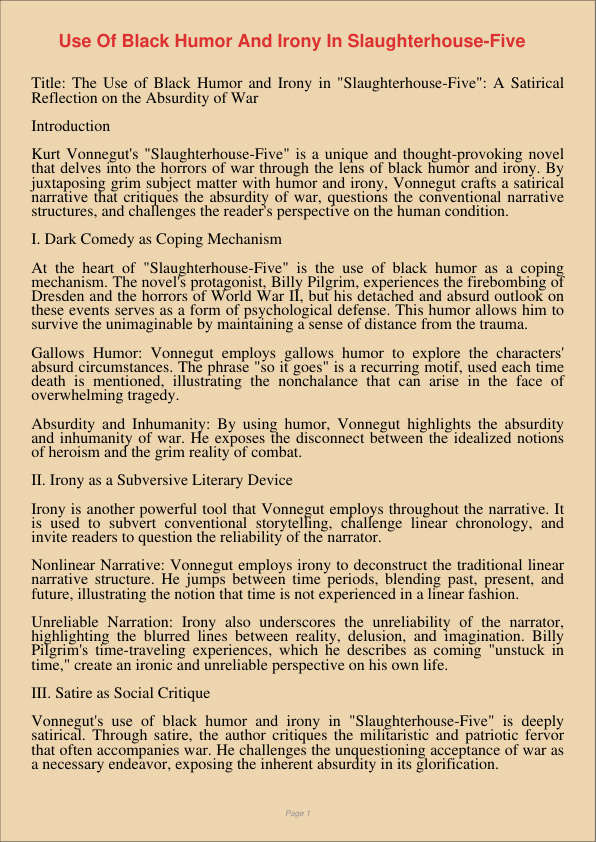Use Of Black Humor And Irony In SlaughterhouseFive
Jan 12, 2024
black humor
use
Religion and Theology
Geography

Title: The Use of Black Humor and Irony in “Slaughterhouse-Five”: A Satirical Reflection on the Absurdity of War
Introduction
Kurt Vonnegut’s “Slaughterhouse-Five” is a unique and thought-provoking novel that delves into the horrors of war through the lens of black humor and irony. By juxtaposing grim subject matter with humor and irony, Vonnegut crafts a satirical narrative that critiques the absurdity of war, questions the conventional narrative structures, and challenges the reader’s perspective on the human condition.
I. Dark Comedy as Coping Mechanism
At the heart of “Slaughterhouse-Five” is the use of black humor as a coping mechanism. The novel’s protagonist, Billy Pilgrim, experiences the firebombing of Dresden and the horrors of World War II, but his detached and absurd outlook on these events serves as a form of psychological defense. This humor allows him to survive the unimaginable by maintaining a sense of distance from the trauma.
Gallows Humor: Vonnegut employs gallows humor to explore the characters’ absurd circumstances. The phrase “so it goes” is a recurring motif, used each time death is mentioned, illustrating the nonchalance that can arise in the face of overwhelming tragedy.
Absurdity and Inhumanity: By using humor, Vonnegut highlights the absurdity and inhumanity of war. He exposes the disconnect between the idealized notions of heroism and the grim reality of combat.
II. Irony as a Subversive Literary Device
Irony is another powerful tool that Vonnegut employs throughout the narrative. It is used to subvert conventional storytelling, challenge linear chronology, and invite readers to question the reliability of the narrator.
Nonlinear Narrative: Vonnegut employs irony to deconstruct the traditional linear narrative structure. He jumps between time periods, blending past, present, and future, illustrating the notion that time is not experienced in a linear fashion.
Unreliable Narration: Irony also underscores the unreliability of the narrator, highlighting the blurred lines between reality, delusion, and imagination. Billy Pilgrim’s time-traveling experiences, which he describes as coming “unstuck in time,” create an ironic and unreliable perspective on his own life.
III. Satire as Social Critique
Vonnegut’s use of black humor and irony in “Slaughterhouse-Five” is deeply satirical. Through satire, the author critiques the militaristic and patriotic fervor that often accompanies war. He challenges the unquestioning acceptance of war as a necessary endeavor, exposing the inherent absurdity in its glorification.
Dehumanization: Vonnegut satirically illustrates how war dehumanizes individuals, rendering them as expendable pawns. The absurdity of the “Children’s Crusade” and the transformation of soldiers into mindless automatons are stark examples.
Absurdity of Violence: The novel uses irony to confront the absurdity of violence. The firebombing of Dresden is presented not as a heroic battle but as an act of senseless destruction. This challenges the conventional portrayal of warfare.
Conclusion
In “Slaughterhouse-Five,” Kurt Vonnegut masterfully employs black humor and irony to craft a unique and compelling narrative. These literary devices serve as a lens through which readers can confront the absurdity of war, the emotional toll it exacts on those who experience it, and the dissonance between the idealized narratives of heroism and the harsh realities of combat. By using humor and irony as coping mechanisms and satirical tools, Vonnegut invites readers to question the conventional wisdom surrounding war and the human condition. Through his unconventional narrative style, he challenges the traditional linear structure of storytelling and offers a perspective that is both disorienting and illuminating, ultimately encouraging readers to reflect on the inherent contradictions and complexities of war and humanity.